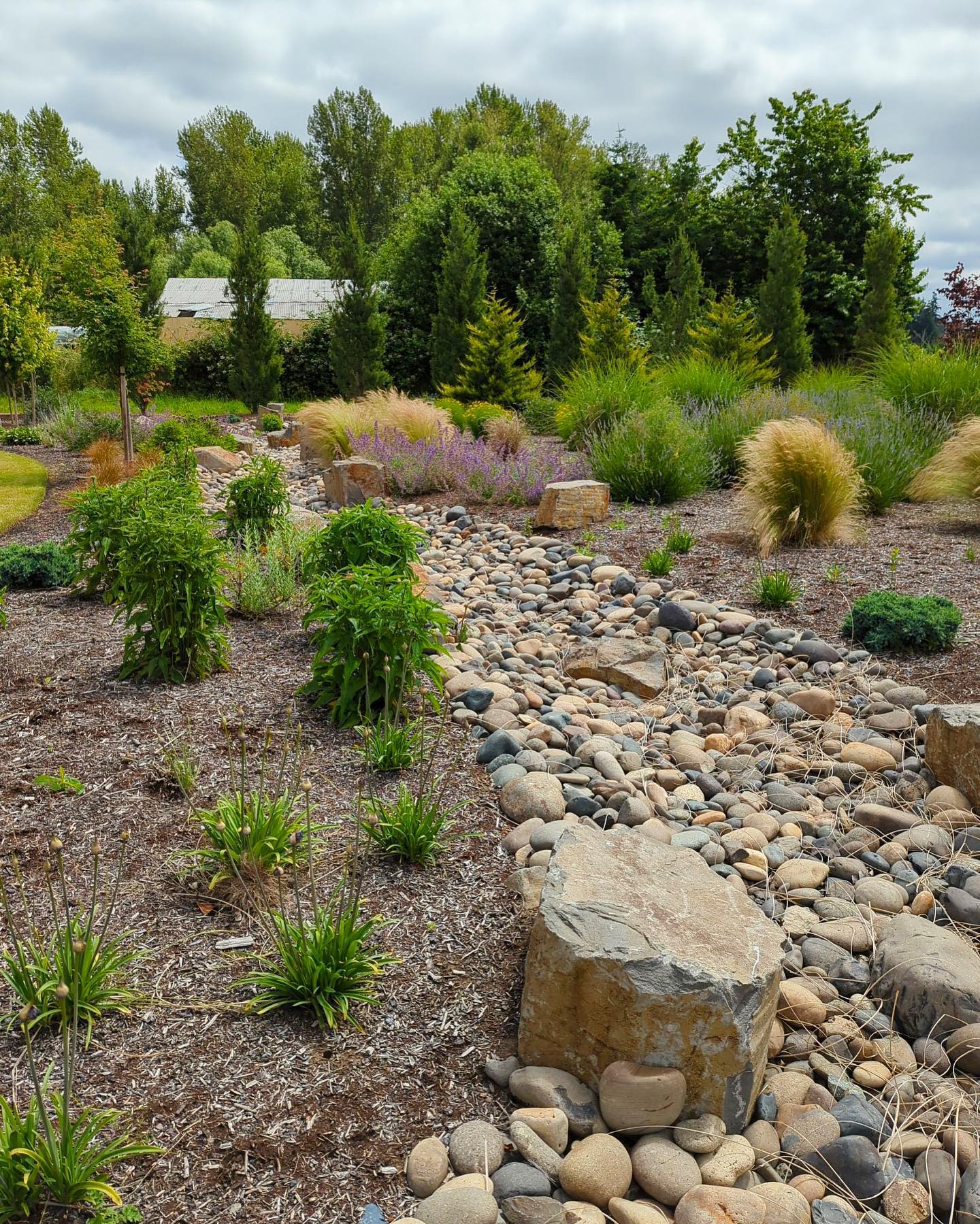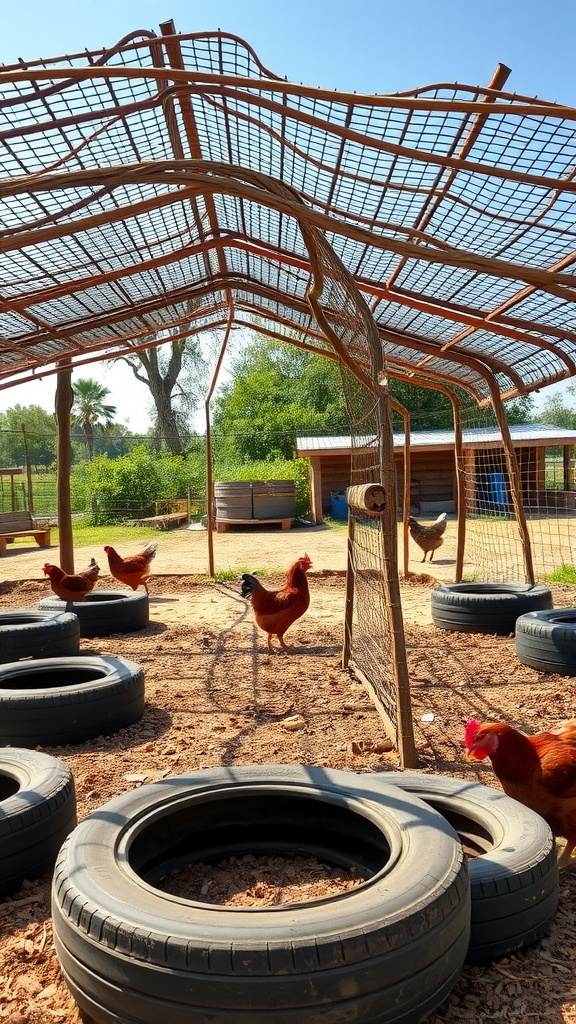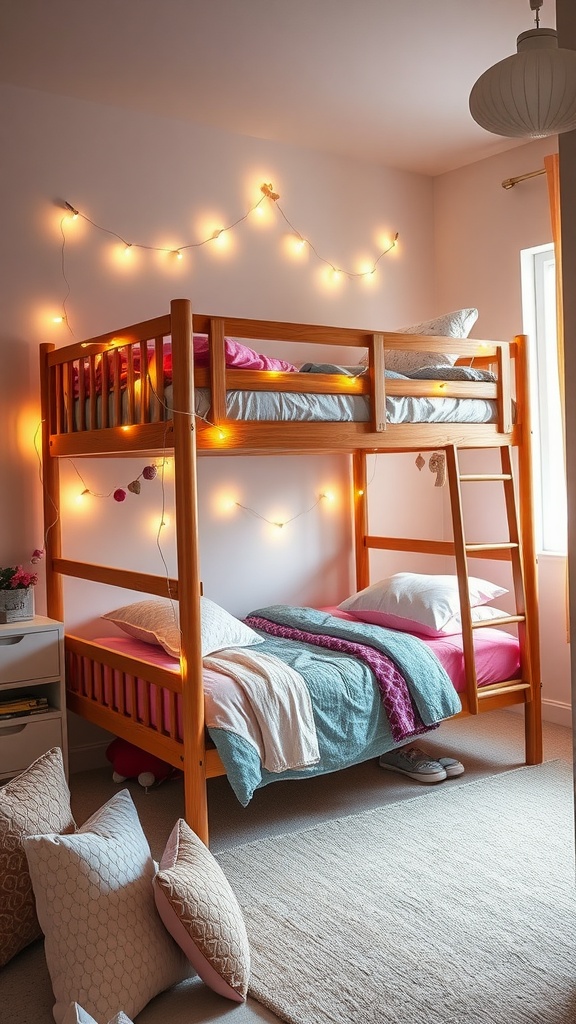25 Beautiful and Practical Rainscaping Ideas to Transform Your Yard
Rainy days don’t have to put a damper on your outdoor space. In fact, with the right rainscaping ideas, those gloomy skies can bring your yard to life.
Whether you want to boost your curb appeal, protect your home from water damage, or create a backyard sanctuary that’s as beautiful as it is functional, rainscaping is the secret weapon for every modern outdoor living space. From artistic touches to eco-friendly features, this list offers practical inspiration for every style — especially if you’re someone who loves a blend of nature and design.
Let’s dive in!
1. Create a Charming Rain Garden

A rain garden is one of the most beautiful and effective rainscaping solutions. These shallow, plant-filled depressions are designed to collect rainwater runoff from roofs, driveways, and patios. Instead of letting water pool or flow into the street, a rain garden filters it naturally through soil and plant roots.
It’s like having a mini wetland in your yard — one that’s full of native grasses, flowers, and pollinators like butterflies and bees. Not only does it support local wildlife, but it also adds colorful, low-maintenance charm to your landscape.
If you’re looking to elevate your back porch decor, consider situating a rain garden just off your patio. It’ll bring a pop of seasonal color while serving a purpose, too. Pair it with modern patio furniture nearby to create a relaxing view after a summer rain.
The best part? You can tailor your rain garden to your climate and style, whether that’s minimalist, rustic, or cottage-inspired.
2. Install a Decorative Rain Chain

Swap out those boring downspouts for something that turns every rainfall into a soothing backyard performance. A rain chain is both functional and beautiful — it guides rainwater from your gutters to the ground using a chain of cups, rings, or decorative shapes.
You can find them in copper, brushed metal, or ceramic, and they’re especially eye-catching in modern or Japanese-inspired garden designs. As the water flows, it creates a soft trickling sound that adds to the overall ambiance of your outdoor living space.
For a truly intentional design, place a rock basin or small rain barrel at the bottom of the chain to collect the runoff. Add some low-light landscaping around it for a magical, spa-like feel next to your modern back porch.
This is a great project for homeowners who want quick, impactful change without heavy digging or landscaping.
3. Use Permeable Pavers for Your Patio
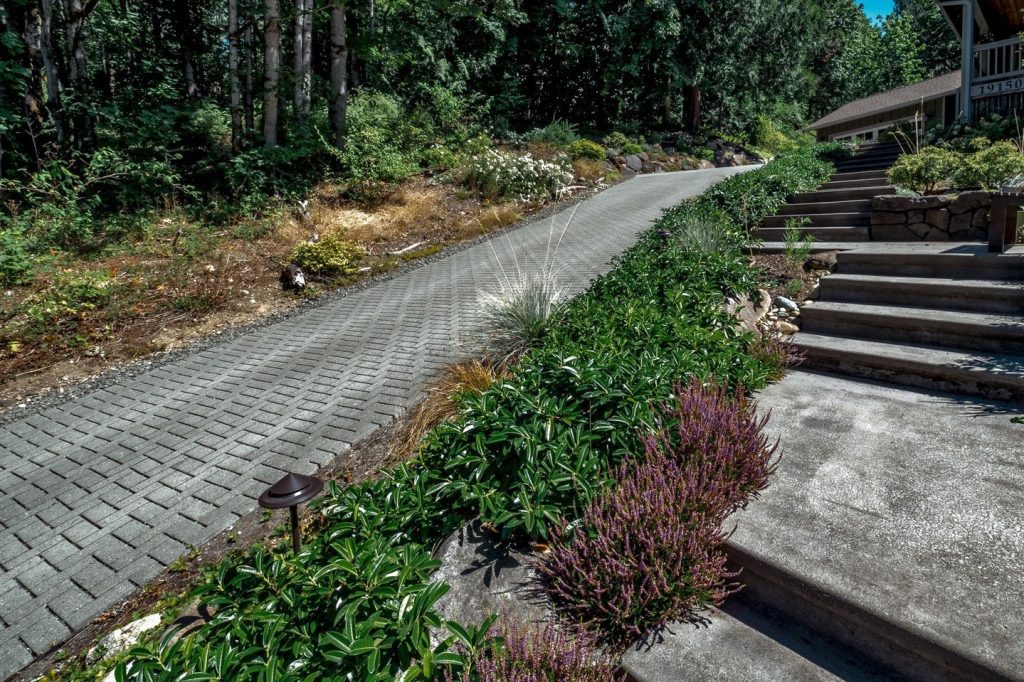
Traditional concrete can cause water to pool and run off quickly, but permeable pavers allow rain to seep into the ground slowly, reducing erosion and helping recharge groundwater.
Think of these as the perfect blend of beauty and brains. You can choose from stone, brick, or concrete pavers designed with small gaps or porous material that naturally manage water while looking sleek and stylish. They’re perfect under modern patio furniture, walkways, or even driveway upgrades.
Permeable pavers work well in both contemporary and traditional designs. You can even plant moss or grass between the joints for added softness and a pop of green.
It’s a smart, eco-conscious update that gives your outdoor space a polished look without sacrificing function. Plus, it makes your patio safer and less slippery during wet seasons.
4. Design a Dry Creek Bed
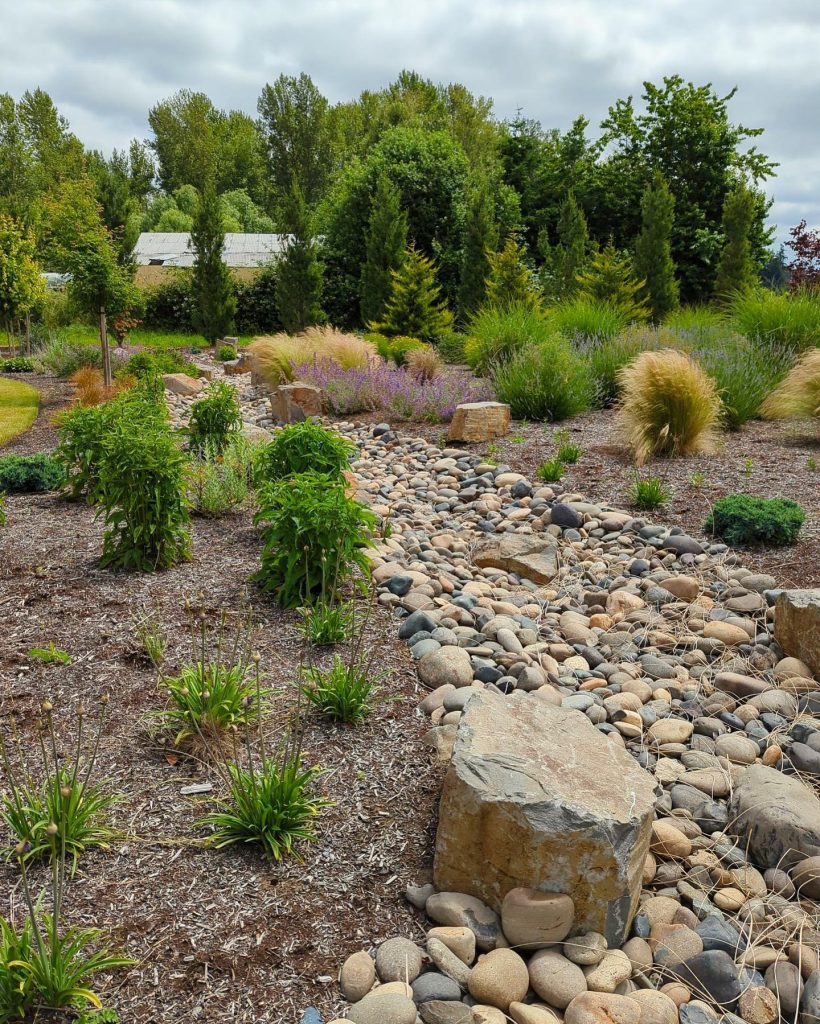
A dry creek bed is a show-stopping way to guide rainwater through your yard while adding a beautiful, natural feature.
Made from river rocks, gravel, and strategically placed boulders, a dry creek bed mimics the look of a natural stream — minus the constant water flow. It captures and channels runoff during heavy rains, then blends back into the landscape when dry.
Use it to connect gutter downspouts to a rain garden, or to direct water away from your home’s foundation. You can even line the edges with native plants or grasses for a lush, organic border.
If you’re into outdoor living spaces that feel grounded and serene, a dry creek bed brings both structure and charm. It’s especially useful on sloped yards or in areas prone to puddles and erosion.
5. Add a Curbside Bioswale
Source
Perfect for suburban and city lots alike, a bioswale is a shallow, planted channel that filters stormwater before it reaches drains or streets.
Think of it as a stylish little moat that runs along the edge of your yard or driveway. It slows down water, encourages it to soak in, and captures pollutants before they wash away.
You can fill a bioswale with colorful native perennials, grasses, and stones to match your existing back porch decor or front-yard aesthetic. And it doesn’t just look good — it’s a proactive way to reduce localized flooding and support healthy waterways.
If you’re the kind of homeowner who wants their space to be both beautiful and smart, this is a modern, eco-forward solution that blends form and function.
6. Go for a Rain Barrel with Personality
Source
Rain barrels don’t have to be dull. Today’s designs range from rustic wine barrels to sleek, contemporary urns that double as decor.
A rain barrel sits under a downspout and captures runoff from your roof, giving you a sustainable way to water your garden or lawn. It’s a budget-friendly, eco-conscious choice that makes a huge impact over time.
Place it on a decorative stand and paint it to match your modern back porch color scheme. Add a hose connector, and you’ve got a free source of water for your container garden or flower beds.
Rain barrels can store between 40–80 gallons depending on the size, and they help reduce water bills while keeping your plants happy. Bonus: they make you feel like a water-saving queen every time you use them.
7. Layer with Native Plants
Source
Native plants are the ultimate low-maintenance, high-impact addition to any rainscaped yard. Because they’re adapted to your local climate, they thrive with minimal care and make the most of natural rainfall.
Think of layers: tall grasses in the back, pollinator flowers in the middle, and ground cover in front. This not only helps manage rainwater but also creates visual interest and supports birds, bees, and butterflies.
If you’re going for a modern porch decor vibe, choose plants with interesting textures and tones — like purple coneflower, blue grama grass, or yarrow. Arrange them in clusters for a curated, designer look.
The result is a landscape that feels both wild and intentional, perfect for anyone looking to combine sustainability with beauty.
8. Edge Beds with Gravel Traps
Source
A simple but powerful rainscaping trick? Line your flower beds or walkways with gravel trenches to capture runoff and prevent erosion.
These narrow gravel borders — also called gravel traps — slow the flow of water and allow it to seep gently into the soil. They’re especially effective around patios, garden edges, and sloped areas.
Choose smooth river rock for a soft, natural look, or go with crushed gravel for a modern, minimalist edge. Either way, it keeps mulch in place, reduces muddy splash-back, and enhances drainage — all while giving your garden a clean, finished appearance.
Pair this with modern patio furniture for an outdoor space that feels intentional and polished, even during a downpour.
9. Build a Mini Wetland
Source
Have a low-lying or soggy spot in your yard? Don’t fight it — embrace it with a mini wetland garden.
Wetland areas are naturally excellent at filtering water and supporting biodiversity. You can build one by digging a shallow depression, lining it with organic soil, and filling it with water-loving plants like iris, sedges, or marsh marigold.
The result is a small ecosystem that comes alive with frogs, dragonflies, and native birds. It’s perfect for homeowners who want a touch of the wild in their outdoor living space.
Add a rustic bench or stone path alongside it, and it becomes a peaceful escape during rainy afternoons. Just be sure to plant species suited to your local region for the best results.
10. Install a Living Wall
Source
Vertical gardens aren’t just trendy — they’re perfect for managing moisture in small or narrow spaces.
A living wall is a vertical structure covered in plants that naturally absorb rainwater and provide insulation. You can build one with stacked planters, modular panels, or trellises filled with trailing plants like ferns, succulents, or even edible herbs.
They’re ideal for porches, patios, or fence lines, especially if you’re tight on space but big on design. If you’ve been eyeing modern back porch ideas, this one adds a bold, green accent that’s both practical and chic.
It’s also a fantastic way to reduce splash zones near your home’s foundation, while enhancing your home’s value and charm.
11. Construct a Rainwater Harvesting System
Source
If you want to go beyond the basic rain barrel, a full rainwater harvesting system might be your next big home upgrade.
These systems collect rainwater from your roof and store it in large tanks for use in irrigation, outdoor cleaning, or even indoor greywater systems (in some states).
They’re especially useful in areas with seasonal drought or strict watering regulations. And while the initial investment is higher, the long-term savings and eco-benefits are well worth it.
Design-wise, many modern tanks come in sleek, space-saving styles that blend beautifully with back porch decor. You can even screen them with lattice, wood slats, or tall grasses for a seamless look.
12. Try a French Drain with a Flair
Source
French drains are a classic solution for managing water — but that doesn’t mean they can’t look fabulous.
These underground systems use gravel and perforated pipe to direct water away from your home or garden. The top layer is usually filled with decorative stones or groundcover plants, making it nearly invisible.
To add flair, edge your French drain with bricks or pavers, or design a pathway over it using permeable stepping stones. It’s a great way to blend utility with style, especially in modern patio layouts.
French drains are ideal for dealing with persistent wet spots, preventing basement leaks, and protecting your home’s foundation.
13. Add a Pollinator Border Around Downspouts
Source
Turn your downspouts into pollinator party zones with a vibrant border of native flowers.
This is a clever way to handle water runoff while attracting butterflies, hummingbirds, and bees. Use perennials that love moisture, such as bee balm, black-eyed Susan, or swamp milkweed.
Place them in a curved or crescent shape around the base of your downspouts for a soft, welcoming look that complements any modern back porch. Add river rocks in between for visual contrast and extra drainage.
It’s a feel-good update that combines purpose and personality — and gives your garden a natural charm that blooms from season to season.
14. Use Mulch Like a Pro
Source
Mulch might seem basic, but it’s one of the most effective and affordable rainscaping tools out there. By covering your soil with a layer of organic material — like shredded bark, wood chips, or pine straw — you slow down water runoff, reduce evaporation, and protect plant roots from erosion.
A thick mulch layer helps absorb rainwater where it falls, encouraging it to soak into the ground instead of running off into storm drains. And with so many styles and colors available, mulch can also elevate your back porch decor by giving your garden beds a clean, finished look.
Don’t just toss it around, though — use mulch with intention. Apply it two to three inches thick around trees, shrubs, and flower beds, keeping it a few inches away from stems or trunks.
It’s a small step with a big impact — making your garden more drought-tolerant, weed-resistant, and gorgeous all at once.
15. Convert Your Lawn into a Meadow
Source
Tired of mowing a thirsty lawn that drinks more than it gives? Try converting part (or all) of it into a vibrant meadow.
Native meadows use drought-tolerant grasses and wildflowers to create a soft, flowing space that absorbs rainwater naturally. These low-maintenance landscapes reduce the need for irrigation, attract pollinators, and cut down on the time and energy you spend maintaining your yard.
You don’t need acres — even a small patch of meadow can make a huge difference. Choose a mix of native seeds suited to your region, and let them work their magic. The result is a yard that feels wild, natural, and deeply connected to the seasons.
For modern back porch ideas, frame your meadow with clean lines — think gravel borders, stepping stones, or sleek fencing — to keep the look intentional and contemporary.
16. Plant a Sedge Lawn Alternative
Source
If you’re not ready to go full-meadow, a sedge lawn offers a lush, green alternative to traditional turf — with far less water and maintenance required.
Sedges are low-growing, grass-like perennials that thrive in both sun and shade. Many native species are well-suited to rainy areas, with deep root systems that help soak up water and prevent runoff.
What makes sedge special is its soft texture and natural elegance. It doesn’t need mowing often (if at all), and it blends beautifully into outdoor living designs that lean toward natural or minimalist aesthetics.
It’s perfect for small yards, shaded areas, or eco-conscious homeowners who want beauty without the upkeep. Add a modern bench or small bistro set nearby, and your lawn becomes your new favorite hangout.
17. Dig a Swale for Natural Drainage
Source
A swale is a shallow, gently sloping channel that moves water across your landscape without the need for pipes or drains.
This might sound overly technical, but it’s actually a beautiful, low-impact way to manage rainwater — especially on sloped lots. You can line the bottom of a swale with river rock, plant it with grasses, or even design it to double as a walking path.
Swales are great for diverting runoff from roofs or patios to rain gardens or infiltration areas. They help slow down heavy rain, giving it time to soak into the soil instead of pooling or eroding your yard.
Incorporate a swale as part of your modern patio or garden design, and it becomes both a functional and aesthetic feature. With the right layout and planting, it can even feel like a natural stream bed.
18. Add Stepping Stones with Gaps
Source
Sometimes, the little details make all the difference. By installing stepping stones with gaps — rather than solid paths — you allow water to filter into the soil instead of running off.
This simple trick works beautifully in gardens, around back porch decor, or along walkways. You can use natural stone, concrete pavers, or recycled materials, then plant low-growing ground covers like creeping thyme or moss in between.
Not only does this soften the look of your landscape, but it also helps break up compacted soil and improve drainage.
It’s an easy DIY project that elevates your yard’s style while staying true to your rainscaping goals. Think of it as adding a touch of garden poetry that serves a purpose.
19. Incorporate a Water Feature
Source
There’s something magical about water — especially when it’s flowing gently in your own yard.
Adding a small fountain, bubbling rock, or recirculating stream creates a calming ambiance that also encourages water collection and reuse.
Modern water features can be self-contained (great for patios or balconies) or integrated into a larger rain garden or basin. Many designs today are solar-powered or energy-efficient, so they’re as sustainable as they are stunning.
Place a water feature near your modern back porch seating area for a spa-like effect, or tuck it into a garden corner for a serene retreat. Surround it with moisture-loving plants to turn it into a complete ecosystem.
20. Install a Rain Curtain
Source
Want a show-stopping feature that manages water and wows your guests? A rain curtain might be just what your space needs.
A rain curtain is a vertical sheet of falling water that can be installed along eaves, pergolas, or garden walls. It adds movement and sound to your space while directing rainwater exactly where you want it — like into a rain garden or basin.
Made from stainless steel or acrylic, these modern designs look stunning in outdoor living areas that embrace sleek lines and sculptural elements. They’re also surprisingly water-efficient since they reuse the same flow during dry spells.
This is a bolder rainscaping idea, but one that pays off in drama, function, and curb appeal.
21. Design a Downspout Rock Garden
Source
Downspouts are often overlooked — but they don’t have to be boring.
Instead of letting rainwater splash onto bare soil or concrete, create a small rock garden at the base of each downspout. Use river stones, gravel, and hardy plants to slow the water and prevent erosion.
This simple feature adds a touch of zen to your yard while keeping things tidy and functional. You can even frame the area with bricks, edging, or driftwood for an extra decorative flair.
These gardens are perfect next to modern porch decor where you want everything to look curated and complete. Bonus: no more muddy puddles!
22. Surround Trees with a Rain Capture Ring
Source
Trees are natural water lovers, and you can help them thrive by building a rain capture ring around their base.
This involves digging a shallow trench in a circular shape around the tree and filling it with mulch or compost. As rain falls, it collects in the ring and soaks deep into the soil where tree roots can access it.
It’s a simple but effective way to support tree health, especially in dry climates or during drought seasons.
Use decorative mulch or small stones to style the ring to match your back porch decor or overall garden theme. It’s both practical and beautiful — just like the rest of your rainscaping strategy.
23. Use Raised Beds with Smart Drainage
Source
Raised garden beds are a staple of modern yards, but they can also be a smart part of your rainscaping plan.
By elevating your planting area and adding proper drainage layers (like gravel and compost), you prevent waterlogging during heavy rains while still capturing and using that moisture effectively.
Raised beds are perfect for veggies, herbs, or ornamental plants, and they allow you to control soil quality and drainage more precisely. You can even build them with built-in overflow channels to direct excess water to a rain garden.
Style-wise, raised beds are super flexible — go rustic with reclaimed wood or chic with sleek metal frames. They pair beautifully with modern patio furniture and add structure to any garden layout.
24. Add a Pebble Mosaic Path
Source
If you’re looking for a way to make a big visual impact while still supporting good drainage, try installing a pebble mosaic path.
These stunning walkways are made from smooth stones arranged in artistic patterns — spirals, waves, floral motifs — that allow water to pass through easily.
They’re perfect for connecting spaces in your garden, leading to your modern back porch, or even adding flair to a side yard. Plus, they’re naturally slip-resistant, making them a smart choice during rainy seasons.
Pebble mosaics combine form and function like few other features — transforming your yard into a personalized work of art that celebrates every drop of rain.
25. Mix Function with Art
Source
Sometimes the best rainscaping ideas are the ones that don’t look like rainscaping at all.
Consider incorporating functional water-capturing elements that double as artistic centerpieces — like a sculptural basin that collects rainwater, a mosaic water wall, or a carved wooden gutter.
These unique touches let you express your personality while still doing the important work of managing stormwater. Whether your style is boho, modern, minimalist, or cottage-chic, there’s a way to blend design and sustainability seamlessly.
Look for materials that hold up well in the weather — like copper, stone, or resin — and integrate them naturally into your outdoor living setup.
When art meets purpose, the results are unforgettable.
Conclusion
Rainscaping isn’t just about preventing puddles or runoff — it’s about turning your yard into a space that thrives with every drop of rain.
From charming rain gardens to bold rain curtains, each of these ideas helps you create a landscape that’s beautiful, eco-friendly, and uniquely you. Whether you’re working with a cozy backyard or a full front lawn, there’s a solution here to fit your lifestyle, climate, and design vision.
Start small or go big — just start. Because when your outdoor space is in harmony with nature, every rainfall becomes an opportunity to grow something extraordinary.

